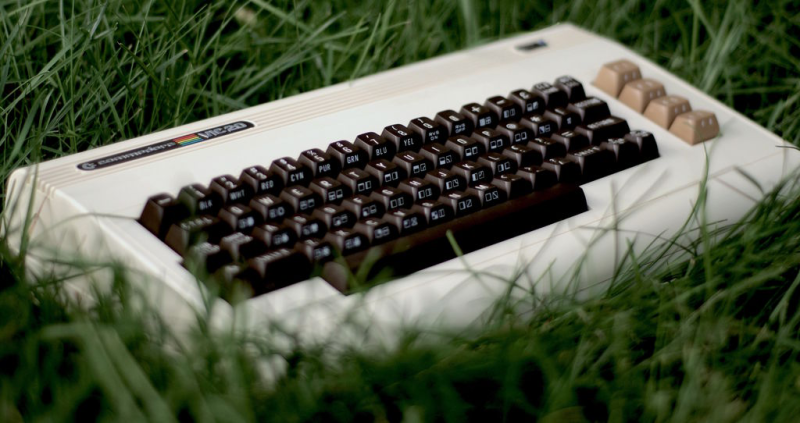What was the first computer you bent to your programmatic will? If you’re old enough, it was probably a Commodore. For [Jagged-path], it was a VIC-20. After finding a broken one on Kijiji, he recaptured that 80s feeling with VicPi, a revitalization project that marries modern computing power with vintage form factor.
The VicPi can be used as a standalone computer or a USB keyboard for an external computer. As you’ve probably guessed, there’s a Raspberry Pi involved. There is also a Keyrah board, which is arguably the easiest way to convert Commodore (and Amiga) keystrokes to USB without breaking a sweat.
There are a lot of nice touches that really make this project. A toggle switch on the back selects between VicPi mode and keyboard mode, and the distinction is made with a two-color LED in place of the VIC-20’s power LED. [Jagged-path] used panel mount cables to extend the HDMI, 3.5mm, and USB ports and ran them out to a custom metal panel that’s treated with rubberized black paint. Another nice touch: the dedicated keyboard port is USB-B, so it’s easy to differentiate from the Pi inputs.
If you have a working VIC-20 but not the rare Votrax Type ‘n Talk synthesizer peripheral, you can use an old Android phone to hear those Voodoo Castle responses.
















Looks like a crappy hack. I would have pulled the 2nd joystick port, and put the Keyrah in the correct location. Then put the A/V connectors of the Pi towards the back.
Also, chances are that VIC-20 was completely repairable.
Shh.. if you don’t make positive comments about the article, you’ll get censored.
You’re thinking of the C64. The VIC-20 only has one joystick port.
Though I agree that the VIC was likely completely repairable. Hopefully he didn’t just throw the components out…
For me it was an Altair 8800b.
“What was the first computer you bent to your programmatic will?”
Waiting for someone to cram a Raspberry Pi into a PDP.
You didn’t specify wherther PDP-8 or PDP-11… ;-)
https://www.raspberrypi.org/blog/pidp-8i-remaking-the-pdp-8i/
http://obsolescenceguaranteed.blogspot.com/2016/01/starting-to-make-pidp-1170.html
https://hackaday.com/2015/12/12/turning-a-pi-into-a-pdp/
http://www.instructables.com/id/PiDP-8-a-Raspberry-Pi-As-PDP-8-Minicomputer/
Not that they crammed one into a PDP, but I thought HaD had an article about a Pi (or some other ucontroller) wired to a PDP faceplate (or was it a custom build to look like a PDP faceplate?).
Obpun: PDPi
PiDP is the name of the actual project.
http://obsolescence.wixsite.com/obsolescence/pidp-8
Meh, should have used a 555.
Can be done on a single ATmega Arduino.
https://create.arduino.cc/projecthub/janost/the-nano-vic-20-e37b39
I love that it ends up with even less memory free than the already constrained original VIC-20. Pretty cool project.
You can add a 23LC1024 DIP-8 for 128K ram.
But then it wont be single chip anymore.
Wonder where he got the 6502 emulator. Optimized cores for AVR assembly could be a good basis for an open-source project.
The 6502 emulator cpu.c core is written by Mike Chambers.
I got permission to use it in my VIC-20 and C64 emulators for the Arduino platform.
There are 6502 emu’s written in AVR assembly but not all of them are open-source.
As much as I love my VIC-20, it’s actually not very pleasant to type on for extended periods of time, unless you have a pretty serious pillow to rest your forearms on.
Interesting project, but I’d much rather see this built up from parts bought off eBay (keyboard & case), rather than take a VIC-20 that could have been repaired off the streets. I hope he sold or donated the original components on to someone.
I love the VIC-20, built like a tank. Newer Commodores didn’t seem to stand up as well. I’ve one that’s bricked, but the old VIC still worked last I tested it. I worry about the capacitors though…
I liked my Commodore-64. I remember having to buy like 3 of them until I finally got one that worked. But the one I ended up with worked fine with no issues. One of the fun things that I did with it was used it for a terminal for my S-100 CP/M systems (Altairs and a couple of no-names). I wrote a little program loader that I could key in real quick that would turn around and pull down the actual terminal program itself from the floppy disk on one of the S-100 systems. One of the reasons I really liked it was because, unlike the typical black&white (or green&white) ASCII terminals of the day, using the C64 as a terminal let me do color graphics and color text– albeit on a 40-char wide TV screen. But it was cool for the time.
I let the smoke out of my Vic 20 by accident as a kid. The boombox at the time in my room had the same end on the cord (but no transformer).
Sooner or later someone’s going to crack open a case to fit a PI inside and find one already in there.
B^)
I still have three VIC-20 waiting for modifications. My first computer was VIC-20 with 50kB of RAM, 2kB of that was NOVARAM, 64kB of stacked ROM, 6 parallel ports, two rs232, a counter card and a stepper driver card. The stepper drivers and the counter were there for the dual chrystal x-ray spectroscope. The serial ports for the connectio to the mainframe.
Of course you know there was a forgotten 4kB slot in the memory chart of VIC-20 ? It can be used, if you build a module yourself.
Next I’m going to build Raspi inside one of the VIC20.